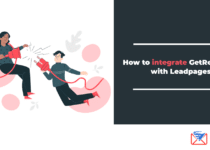Boost your online business: Integrate GetResponse with Shopify
 If you haven’t considered email marketing for your online business, you should! Watch your business grow when you integrate GetResponse with Shopify.
If you haven’t considered email marketing for your online business, you should! Watch your business grow when you integrate GetResponse with Shopify.
Shopify is one of the most popular eCommerce platforms for online businesses, so it comes to no surprise that plenty of other tools can be integrated with it. Specifically for email marketing, one of the best tools that you can integrate with Shopify is GetResponse.
What is email marketing?
Email marketing is the method of sending marketing messages to prospective and current customers through email to sell, educate, or build loyalty.
An email is a form of digital marketing channel, wherein the sender fully controls the content and distribution. It typically works best when used to send personal, relevant messages to segmented lists of recipients. Email is an especially important tool in eCommerce, where it’s used for sending transactional, promotional, and lifecycle messages.
Get our FREE course on AFFILIATE MARKETING straight to your inbox
This course includes video tutorials on how to do email marketing.
Why email marketing is key to Shopify success
The reality in website traffic is that most new visitors of your online store might never return, even highly targeted traffic. That is, of course, unless you do something to keep them coming back.
Building an email list and sending compelling broadcasts gives you a way to retain the traffic you worked so hard to earn by providing subscribers with an incentive to stay in touch.
If your eCommerce business hasn’t taken the time to adopt email marketing, you’re likely leaving money on the table. Here are five reasons to consider employing email in your marketing mix for your Shopify store.
- Email lets you build ongoing customer relationships
Search engines and social media platforms are great for getting discovered by future customers. Still, email remains the best way to maintain and strengthen existing relationships over time.
According to a Nielsen study, 66% of online consumers prefer to buy new products from brands they are familiar with. Email also plays a pivotal role in encouraging a customer’s second purchase and beyond. Having customers return is essential for many businesses because it keeps their average cost of acquiring a customer down.
- Email is incredibly effective at driving sales
Certain products and services combine well with email marketing, and returns are never guaranteed. Email is a high-performing channel that frequently outperforms the alternatives.
- Email can affect the three main growth multipliers
Most entrepreneurs pursuing an acquisition “silver bullet” usually end up disappointed and discover that acquiring customers can quickly get expensive. Email marketing offers a viable way out of the acquisition rat race because it can influence all growth multipliers at the same time.
- Third-party gatekeepers don’t influence email
One aspect of email marketing that continues to grow in importance is that email isn’t subject to the whims of centralized platforms, where unplanned tweaks to algorithms can completely derail a distribution strategy.
How to get started with email marketing
Even the best email marketing strategy begins with choosing an email marketing service, establishing a plan to generate new subscribers, and understanding how to send emails legally.
- Choose an email service provider
The first step in getting started with email marketing is to choose email marketing software through which you’ll begin building your list. There are many robust and cost-effective email marketing tools to choose from, so don’t get caught up trying to pick one that’s perfect.
You can always switch providers down the line. Instead, pick a well-reviewed solution that fits your needs. Consider the pricing, drag-and-drop editors, email templates, etc. Afterward, start emailing and driving sales.
- Start building your email list
Ask any online business owner about their biggest marketing regret, and many will tell you it’s that they didn’t start collecting email addresses from Day 1. Learn from this frequent mistake and start growing your list of subscribers as soon as you can, even before you launch your business.
A key thing to know before you begin building your email list is that you need permission to follow up with prospects and customers over time. To do that, subscribers need to “opt-in” to hear from you, and there are several ways you can encourage them to do so.
- Send emails legally
Email promotion is an example of “permission marketing,” which means people can opt-in and out of their relationship with your brand as they please. The relationship you build with your email list needs to be based on permission, not just from a marketing standpoint, but a legal one too.
Types of email marketing campaigns to send
Sending irrelevant or unwelcome messages to the wrong people at the wrong time is a surefire way to squander email as a valuable marketing channel.
Below are the different types of campaigns and how you can make them engaging to customers.
There are three core categories of eCommerce marketing emails: transactional, promotional, and lifecycle.
- Transactional emails
These emails are sent during checkout and other purchasing actions. They are more functional, sending vital information to individual customers. Order confirmations, receipts, and order-shipped emails all fall within this category.
- Promotional emails
These emails are designed to raise awareness for a specific deal or promotion. For example, a Black Friday Cyber Monday email, a Mother’s Day gift guide email, a summer savings email, or a limited-time-only discount email would all fall under this category.
- Lifecycle emails
Lifecycle emails are also known as “triggered” emails because they’re sent based on what action a shopper took and where that shopper is in the customer lifecycle. For example, a cart abandonment email only sends after a customer leaves the product in their cart.
How to choose the right email marketing tool for your Shopify store
Every email marketing service is a little different, though most offer a lot of the same basic features. Still, it can be hard to differentiate all of the available options and figure out which one is best for your needs. There are a few basic features every eCommerce business needs in an email marketing service:
- Ready-made templates that can be customized to suit your needs
- Audience-segmentation features for sending targeted emails based on customer profiles
- Smart automation for scaling your email marketing efforts without constant monitoring
- Opt-in forms that can be embedded on your website or integrated with your Shopify store
- Detailed analytics for gauging how an email marketing campaign performs
You’ll also want to make sure the service you choose can handle your intended volume. If you plan to send 5,000 emails a day to 200,000 subscribers, you don’t want a service that caps off below those numbers. You’ll also want to pick a service that falls within your price range.
Why use GetResponse for email marketing
A powerhouse provider of marketing automation, GetResponse goes that little bit further than your average email marketing service. It does this by offering features like landing pages, webinars, and CRM. (READ: Why use GetResponse to grow your email list)
It also happens to be one of the best tools for Shopify email marketing, with its Deep Data integration allowing for the synced customer, order and product data, advanced segmentation and tagging, and automated campaigns.
Pricing:
- Up to 1,000 subscribers: $15/month
- Up to 5,000 subscribers: $45/month
- Up to 10,000 subscribers: $65/month
GetResponse comes with some handy, ready-to-go templates for building out automation for your store, including abandoned cart campaigns, post-purchase emails, and sales promotions.
You can also automatically add Recommended Products to your emails, which are personalized based on customers’ past purchases. This is a super useful feature.
GetResponse is best suited to larger stores. They would benefit the most from the advanced automation, segmentation features, and CRM. It is also recommended if you need extra features such as landing pages and webinars.
(READ More: How to set up GetResponse for email marketing)
Shopify integration with GetResponse
Shopify easily integrates with GetResponse. This means you can automatically add all of your eCommerce customers to GetResponse contact lists, so you can market to them using all the built-in power of GetResponse.
It’s also easy to switch from one contact list to another, so new customers receive up-to-date information and special offers.
Now you can create email marketing campaigns exclusively for your Shopify customers and use Advanced Segmentation to home-in on new pockets of opportunity and profitable niche markets.
How to integrate GetResponse with Shopify
Below are the steps to integrate your Shopify store with GetResponse.
- In the Menu, click Integrations.
- Click Details over the Shopify integration.
- Click Connect to start the integration process.
- Provide your Shopify Shop URL.
- You will be redirected to the Shopify login page. Provide your username, then password and confirm.
New and capable email marketing tools pop up every day. Your goal should be not only to find a solution that’s more than just an excellent email marketing service. You also need a solution that’s the best email software for you, working for your business and your customers, and helping you drive more engagements, more sales, and more loyalty.
GetResponse remains the best tool to use for your Shopify store. With its powerful features, it can help you take your email marketing to greater heights.


